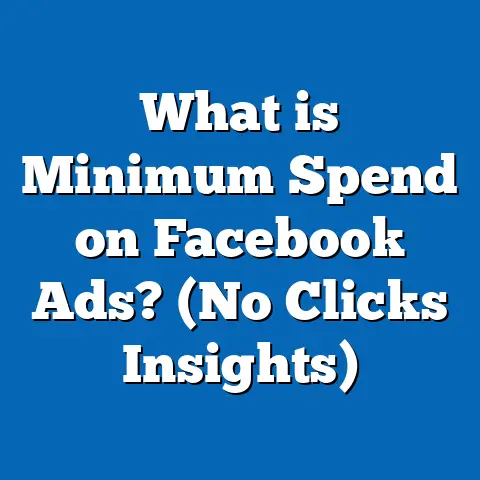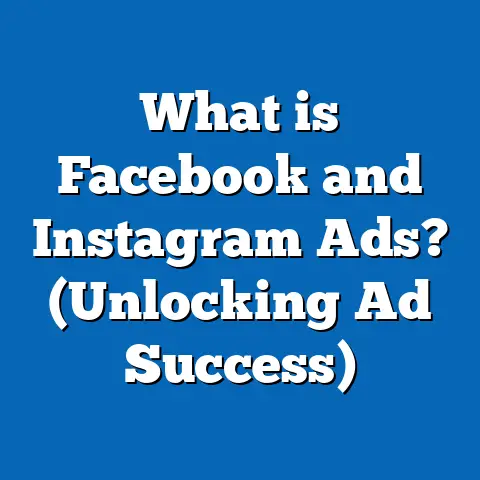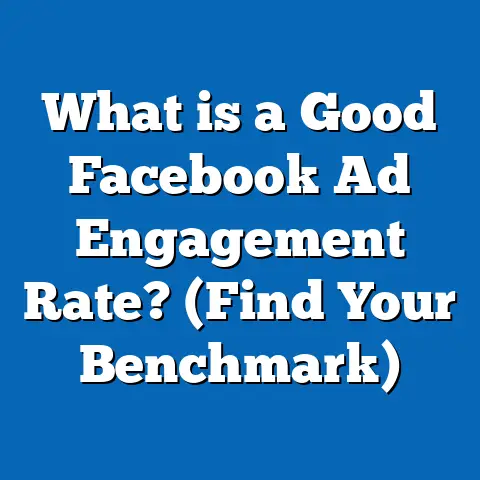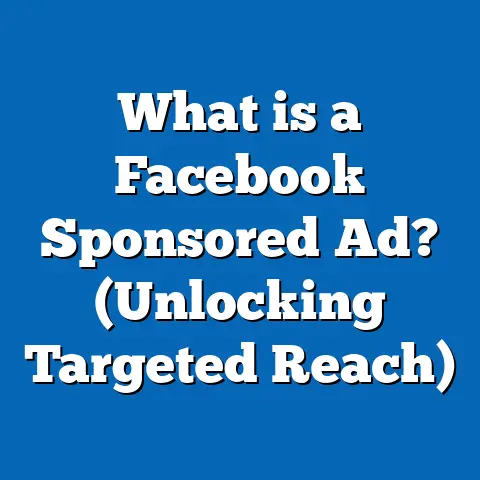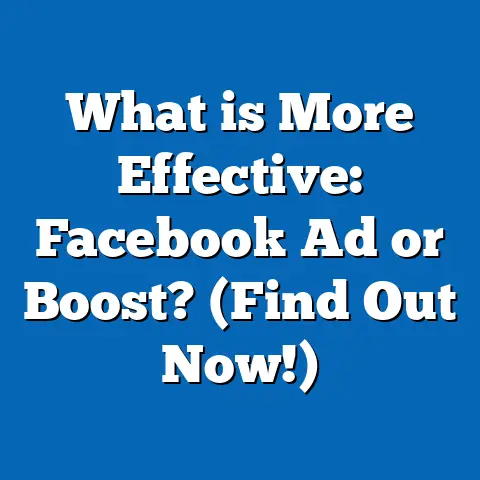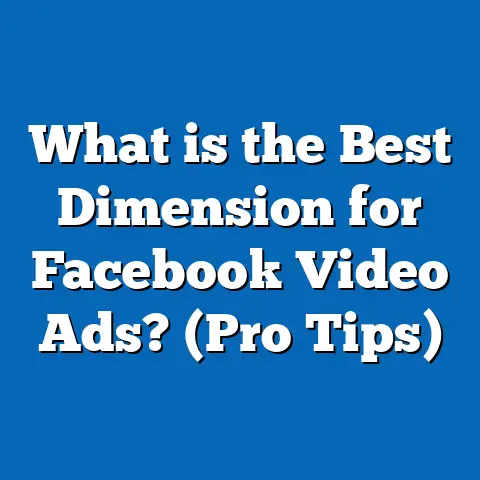What is Ad Recall Lift Rate on Facebook? (Boost Your Ads!)
Introduction: Simplifying Facebook Advertising Success with Ad Recall Lift Rate
In today’s competitive digital landscape, capturing attention is only half the battle. The real challenge lies in making your ads memorable — so your audience not only notices them but also remembers your brand when it matters. Facebook’s Ad Recall Lift Rate is a metric designed to measure exactly that: how well your audience remembers your ads after seeing them.
What sets this metric apart is its accessibility and ease of integration into your existing campaigns. Without complicated setups or invasive tracking, Facebook provides you with data-driven insights to evaluate the true impact of your advertising on brand awareness. This makes it an indispensable tool for marketers and business owners aiming to boost ad effectiveness and maximize return on investment (ROI).
This guide will take you step-by-step through the concept, measurement, practical applications, and advanced tactics to leverage Facebook’s Ad Recall Lift Rate. Drawing on data, case studies, and actionable tips, you’ll learn how to transform your ad campaigns from mere visibility drivers into powerful brand builders.
Understanding Ad Recall Lift Rate on Facebook
What Is Ad Recall Lift Rate?
Ad Recall Lift Rate (ARLR) quantifies the increase in the likelihood that people remember seeing your ad compared to those who were not exposed to it. It measures the percentage uplift in ad recall attributable directly to your campaign.
Instead of focusing on clicks or impressions—which often don’t capture whether a viewer actually registered your message—Ad Recall Lift Rate reveals how memorable your ads are.
For example, if the control group has a 10% recall rate (users who did not see your ad), and the exposed group has a 15% recall rate (users who saw your ad), the Ad Recall Lift Rate would be: ARLR=15%−10%10%×100=50%ARLR = \frac{15\% – 10\%}{10\%} \times 100 = 50\%
This means people who saw your ad are 50% more likely to recall it.
Why Measure Ad Recall?
- Brand Awareness: It directly reflects how well your campaign creates brand recognition.
- Campaign Validation: Beyond clicks and impressions, it validates if your message resonates.
- Optimizing Creative: Helps identify which creatives are truly memorable.
- Budget Justification: Supports decisions on where to invest marketing spend.
The Psychological Basis
Memory psychology tells us that repetition, emotional resonance, and distinctiveness improve recall. ARLR captures these effects, providing an empirical window into consumer memory formation through advertising.
How Facebook Calculates Ad Recall Lift Rate
Experimental Design: Test vs Control Groups
Facebook uses a randomized controlled trial approach:
- Test Group: Randomly selected users exposed to your ads.
- Control Group: Similar users who are not shown your ads.
This randomization ensures differences in recall are caused by ad exposure rather than external factors.
Survey Methodology
Facebook deploys in-app surveys asking users questions like:
- “Do you remember seeing this ad?”
- “Which brand was advertised?”
These surveys are anonymized and aggregated to protect privacy. The responses feed into statistical models estimating lift.
Statistical Significance and Confidence Intervals
Facebook reports not just lift but also confidence levels (usually 95%). This indicates the reliability of results — whether the lift is due to chance or a real effect of the ad.
Time Window of Measurement
Recall measurement typically focuses on a 2-day window after the user sees the ad, balancing memory retention and timely feedback.
Why Should Marketers Care About Ad Recall Lift Rate?
Limitations of Traditional Metrics
- Clicks: Can be accidental or low quality.
- Impressions: Do not guarantee engagement or memory.
- Engagement: Likes or comments do not always correlate with purchase intent.
ARLR fills this gap by showing actual memory impact—a better predictor of future consumer behavior.
Business Impact of High Ad Recall
Studies link strong ad recall to:
- Increased brand consideration.
- Higher likelihood of purchase.
- Greater customer lifetime value.
Nielsen’s Global Trust in Advertising report found that ads remembered by consumers drive sales lifts 3x higher than those that aren’t recalled.
Case Example: Brand Recall Drives Conversions
A study by Facebook revealed that a 1% increase in Ad Recall Lift correlates with approximately a 0.5% increase in purchase intent—highlighting its direct link to sales outcomes.
Setting Up Ad Recall Lift Measurement on Facebook
Step 1: Choose Brand Lift as Your Campaign Objective
Within Facebook Ads Manager:
- Select Brand Awareness or Reach objectives.
- Choose Brand Lift Study under advanced options.
Step 2: Define Audience and Budget
Specify demographic targeting and set budgets adequate for meaningful sample size (usually $10,000+ recommended).
Step 3: Create Your Ads
Develop creatives optimized for memorability (more on this later).
Step 4: Launch and Monitor
Facebook will automatically split audiences for test/control groups and run surveys post-exposure.
Step 5: Analyze Results
Access Brand Lift reports showing:
- Ad Recall Lift Rate (%)
- Confidence intervals
- Reach
- Survey response rates
Deep Dive: Interpreting Your Ad Recall Lift Rate Data
What Does a High Lift Mean?
- Your ad is memorable and resonates.
- Messaging is clear.
- Creative elements connect emotionally or visually.
Low or No Lift?
- Ads may be ignored or forgotten.
- Creative may lack impact or clarity.
- Targeting could be too broad or irrelevant.
Use Confidence Intervals
A lift rate with a wide confidence interval is less reliable. Aim for high confidence (95%) before making strategic decisions.
Benchmarks and Industry Standards for Ad Recall Lift Rate
Average Rates by Sector
| Industry | Typical ARLR Range (%) |
|---|---|
| Retail | 5% – 8% |
| Technology | 7% – 12% |
| Entertainment | 8% – 15% |
| Automotive | 4% – 7% |
| Consumer Goods | 6% – 10% |
These numbers depend on campaign type, creative format, target audience, and budget size.
What Determines Variability?
- Video ads tend to produce higher lift than static images.
- Younger demographics often have higher recall rates.
- More focused targeting improves relevancy and recall.
How to Improve Your Facebook Ads’ Recall Rate: Practical Strategies
Strategy #1: Develop Creative That Sticks
Use Strong Visual Branding
Consistent logos, colors, and fonts build brand recognition over time. Brands like Coca-Cola use signature red and cursive fonts for immediate recall.
Tell a Story in Seconds
Narratives help embed memory by linking emotions with visuals. Even short videos can tell mini-stories that resonate deeply.
Focus on Emotionally Relevant Content
Ads that make viewers feel happy, surprised, or inspired create stronger neural connections linked to memory retention.
Clear Call-to-Actions (CTAs)
Ensure CTAs are obvious but not pushy; they should reinforce brand engagement without detracting from recall.
Strategy #2: Leverage Video Ads for Maximum Impact
Why Video?
Facebook reports that video ads generate up to 23% higher Ad Recall than static images due to motion and sound enhancing attention.
Best Practices for Video Ads:
- Keep videos short (15 seconds ideal).
- Use captions since many watch without sound.
- Deliver key messages within the first 3 seconds.
- Include recognizable branding early and throughout.
Strategy #3: Optimize Frequency and Timing
Find the Sweet Spot for Frequency
Too few impressions won’t lodge the ad in memory; too many cause fatigue and annoyance. A frequency of 3–5 exposures per week is optimal for recall without irritation.
Use Dayparting Techniques
Serve ads when your audience is most active to increase chances of attention and recall. Facebook’s analytics tools help identify peak user times.
Strategy #4: Precision Audience Targeting
Create Relevant Audiences Based on Behavior & Interests
Ads shown to people interested in topics related to your product are more likely remembered.
Use Custom Audiences & Lookalikes
Retarget website visitors or customers for higher recall rates as they have prior brand familiarity.
Exclude Irrelevant Viewers
Avoid wasting impressions on users unlikely to engage or remember your brand.
Strategy #5: Continuous Testing and Learning
A/B Test Different Creatives & Placements
Compare which versions generate higher Ad Recall Lift.
Iterate Based on Data
Pause underperforming ads; allocate budget where recall is strongest.
Incorporate User Feedback & Surveys
Use comments and interactions as qualitative insight into what resonates.
Real World Case Studies Highlighting Effective Ad Recall Campaigns
Case Study #1: Retailer Achieves 9% Lift Using Video Storytelling
A mid-sized apparel brand launched a video campaign targeting women aged 18–34. By focusing on lifestyle storytelling with vibrant visuals and clear branding:
- Achieved 9% Ad Recall Lift rate.
- Resulted in a 15% increase in website traffic.
- Sales rose 12% during campaign period.
Key takeaway: Emotional storytelling + video = powerful recall impact.
Case Study #2: Tech Startup Drives 11% Lift with Interactive Ads
A SaaS company used interactive video formats including polls and quizzes tailored for tech enthusiasts:
- Recorded an 11% lift in ad recall.
- Engagement rates doubled compared to static posts.
- Lead quality improved by 20%.
Lesson: Interactive content boosts memorability and engagement simultaneously.
Case Study #3: Consumer Goods Brand Uses Sequential Storytelling for Sustained Recall
A beverage company rolled out sequential ads telling a story over five days:
- Each ad built on the last, increasing familiarity.
- Achieved a cumulative recall lift of 14%.
- Purchase intent increased by 10%.
Sequential storytelling leverages repetition with fresh content to embed memory deeply.
Comparing Facebook’s Ad Recall Lift with Other Platforms’ Brand Measurement Tools
| Feature | Facebook Ad Recall Lift | Google Brand Lift (YouTube) | Twitter Brand Surveys |
|---|---|---|---|
| Primary Focus | Social media ads across FB & IG | Video ads on YouTube | Promoted tweets & video ads |
| Measurement Approach | In-feed surveys & control groups | Video overlays & control groups | Polls & surveys |
| Key Metrics | Ad recall lift %, confidence level | Awareness, consideration, purchase intent | Brand awareness lift |
| Audience Reach | Facebook’s extensive social graph | YouTube’s video audience | Twitter’s user base |
| Creative Formats | Image, video, carousel | Video | Tweet text, video |
Each platform offers unique advantages; Facebook excels in social engagement metrics while YouTube specializes in video-centric brand impact.
Common Challenges When Using Ad Recall Lift Rate Metric
Challenge #1: Survey Bias & Response Rates
Not all users respond equally; some demographics may underreport recall. Mitigation includes large sample sizes and repeated campaigns for accuracy.
Challenge #2: Attribution Complexity
Recall lift shows potential memory impact but doesn’t guarantee sales conversion. It should be paired with conversion tracking to assess ROI fully.
Challenge #3: Cost & Time Considerations
Brand Lift studies require higher budgets ($10k+) and longer timelines (weeks) than typical campaigns but yield deeper insights worth the investment.
Advanced Tactics to Maximize Your Ad Recall Lift Rate on Facebook
Sequential Storytelling Campaigns
Create multi-part campaigns that tell ongoing stories across several days or weeks:
- Builds familiarity gradually.
- Keeps audiences engaged over time.
- Reinforces messaging without repetition fatigue.
Integrate Offline Data Sources for Holistic Measurement
Combine Facebook Brand Lift insights with POS data, CRM systems, or call center analytics to measure real-world sales impact of ad recall improvements.
Experiment with Augmented Reality (AR) Ads
AR experiences provide immersive brand interaction increasing memorability beyond traditional formats. Early adopters report double-digit lifts in recall rates using AR filters/stickers.
Practical Tips for Efficient Use of Brand Lift Studies on Facebook
- Set Clear Objectives: Define what you want to learn from each study — creative effectiveness, audience segmentation, etc.
- Plan Adequate Budget: Invest enough to achieve statistically significant results.
- Use Diverse Creatives: Test multiple formats (video, carousel) for comparative insights.
- Leverage Facebook Analytics: Combine lift data with page engagement metrics for fuller picture.
- Iterate Based on Results: Apply learnings quickly in future campaigns to improve recall continuously.
Summary: Key Takeaways & Next Steps for Marketers
- Ad Recall Lift Rate tells you how much more people remember your ads compared to those who didn’t see them—a vital metric for brand awareness.
- It is measured via controlled experiments using random test/control groups and survey data collected by Facebook.
- High Ad Recall Lift correlates strongly with better business outcomes including purchase intent and sales lift.
- To boost lift rates:
- Create emotionally resonant, visually branded creatives.
- Use video ads optimized for short attention spans.
- Target audiences precisely.
- Optimize ad frequency and timing carefully.
- Continuously test creatives using Brand Lift studies.
- Combine ARLR insights with conversion tracking for full ROI understanding.
- Consider complementary platform tools (Google Brand Lift) for cross-channel measurement.
Next steps:
- Plan your next campaign around maximizing memorability rather than just clicks.
- Set up a Facebook Brand Lift study to benchmark current performance.
- Use data-driven insights to iterate creative and targeting strategies.
- Monitor results regularly and adjust budgets accordingly.
- Explore advanced formats like AR to stay ahead of competition.
Mastering Ad Recall Lift Rate empowers you to create impactful advertising that builds lasting brand relationships and drives measurable business growth on Facebook.
If you want me to prepare detailed templates for Brand Lift campaign setup or creative checklists tailored for different industries, just ask!

